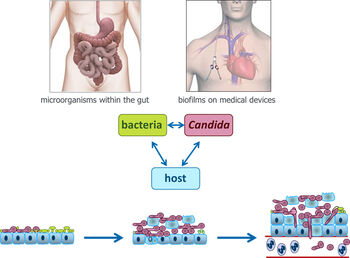CanBac
Interactions of Candida albicans with bacteria

Microbial Biochemistry and Physiology, Friedrich-Schiller-Universität Jena, Institut für Mikrobiologie, und Leibniz Institut für Naturstoff-Forschung und Infektionsbiologie (Hans-Knöll-Institut)
 Candida albicans is the most common cause of life threatening fungal infections in hospitals, including fungal sepsis. Infections are regularly caused by fungal strains that are already present in healthy people as normal habitants (commensals) on mucosal surfaces, in particular the gut. Both as a commensal on mucosal surfaces and during infection, C. albicans interacts not only with the human host, but also with bacterial members of the microbial flora. Animal experiments have, for example, shown that the reduction of gut bacteria with antibiotics is a prerequisite for the dissemination of the fungus from the gut into the blood stream and internal organs. On the other hand, it is also known that C. albicans interacts with pathogenic bacteria, often associated with the cause of sepsis. Furthermore, C. albicans can be found in association with bacteria in biofilms on medical devices; these biofilms are also a common source of fungal infections.
Candida albicans is the most common cause of life threatening fungal infections in hospitals, including fungal sepsis. Infections are regularly caused by fungal strains that are already present in healthy people as normal habitants (commensals) on mucosal surfaces, in particular the gut. Both as a commensal on mucosal surfaces and during infection, C. albicans interacts not only with the human host, but also with bacterial members of the microbial flora. Animal experiments have, for example, shown that the reduction of gut bacteria with antibiotics is a prerequisite for the dissemination of the fungus from the gut into the blood stream and internal organs. On the other hand, it is also known that C. albicans interacts with pathogenic bacteria, often associated with the cause of sepsis. Furthermore, C. albicans can be found in association with bacteria in biofilms on medical devices; these biofilms are also a common source of fungal infections.
The aim of the CanBac project is thus to investigate the interactions of C. albicans with bacteria and the clinical consequences of these interactions. Therefore, cell culture- and animal models will be used to elucidate which microbial genes are involved in the interactions and influence translocation. In parallel, analysis of epithelial cell and immune responses will be used to identify host responses that are crucial to prevent translocation. Using imaging approaches, the colonization, translocation and distribution in the animal will be monitored in real time.
The results of this project will lead to a better understanding of the interactions between different microbes within a human body and will explore whether these interactions have an influence on infectious diseases and sepsis. Our data will help to judge microbiological evidence with regard to risk assessment of patients and may contribute to the development of new prophylactic and therapeutic applications.




